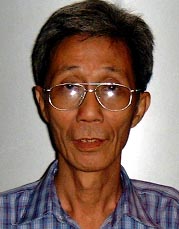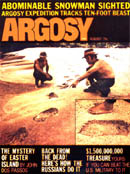
July 31, 2006

Why is the Malaysian situation at such a stalemate?
What the February Johor footprint (above) tells us grows more confusing, but, at least, it is in hand.
As of the last day of July 2006, still no photographs of the unknown hairy hominoids reportedly taken in Johor, Malaysia, have been shown publicly, shared with the scientific community, or published. Drawings, yes, exist, but you will be spared seeing those again here. (You can find them by clicking “Malaysian Bigfoot” in the column to the right.)
Vincent Chow and Sean Ang are using their site, once again, to leak more details of the ongoing Johor Hominid photographic story.
Guardians of Hidden Photos?

Wee Pao Chin
Late in July 2006, Chow and Ang decided to further introduce the world to “JH Guardian and Eyewitness” Wee Pao Chin, a person with “the key to the secrets of the Johor Hominid.” They also mention Philip Tay, another “JH Guardian.”

Philip Tay
Sean Ang writes: “They are not scientists but very ordinary people, carrying on with their seemingly ordinary lives like anyone else. But they have a mission in life which they feel is pre-determined by Providence.”
The Johor Wildlife Protection Society was…
registered in Johor on 13th May 2005 with Lim Chin Eng, aged 50 and a businessman as its President; John Ang, aged 43 as its Deputy and Philip Tay, 64 , as its secretary. Tay is a well-known social activist and a respected member of the local community of Johor Bahru and outer districts. Wee Pao Chin is the key person in the society when it concerns the Johor Hominid. He has intimate knowledge of the creatures and is a firm proponent for their protection. He also keeps close contact with the field members like Chang ( 73) and Kong ( 63) who have been following the hominids closely for many years. Information is updated on a frequent basis by Wee. Photographs of the southern hominids are attributed to Kong who shies away from the public’s eye and only Wee is able to contact him. Kong has been working in the logging camps for 7 years and have seen the creatures many times while another old member of the group based at the northern Malaysia-Thai border (who refused to be named or interviewed) have photographs of the northern hominids.
Chow continues later..(he is using his name in third-person, apparently)…
At the end of 2005 when Vincent Chow brought the Johor Bigfoot issue to the NST, it encouraged Wee to reveal his well-kept secret for years which he did not want to reveal for fear of disbelief and ridicule . It was later related by him that in the early 70s, he had opened a little shop at Kroh, a little sleepy hollow in the north of Malaya where he befriended the individuals who knew about the hominids in the forest there. Subsequently he became engrossed with the creatures for 6 years there and have seen them at least 4 times. He had by then begun to hatch a plan, albeit an impossible one, to find a way for Malaysian and the world to take notice of the hominids which was often in the national news in the 50s, 60s and right up to the 70s. He was aghast with the then public’s view of the hairy creatures and often walked away from disbelievers and deafened by guffaws from skeptics that came by the dozens to listen. He had seen them and they were in the flesh and walking in bright daylight. He found that he was alone in his noble struggle to bring out the truth. When he moved to Johor in the early 80s, he had wanted to form a society to protect the hominids but he had to get people to believe him first but it was difficult. He finally gathered a small group to protect wildlife as he had to start somewhere. When the news of Bigfoot broke out in the news in December, he saw the opportunity to come out into the open about his dream project. He changed course and diverted the members to focus on the hominids. By now, he has already added a new dimension to the society’s aims and objectives. The rest, they say, is history.
A Website in Turmoil?
Recently their site posted an item about the “Cambodian connection,” but it turned out to be hoaxed and they have removed it. Like BFRO, items found to be hoaxed are removed, instead of exposed and left as cautionary tales on the site.
Commenters at Chow’s and Ang’s site have continued asking for the photos and noting such things as…
Cryptomundo published an article on Wee (spelled “Wei Poh Chin”) and his connection to the hominid story more than a week before this site first mentioned him.
The New Straits Times published a story on Philip Tay’s connection five days before this site mentioned him.
Vincent and Sean have been the last to mention these guys – and they’re supposed to have been among the first to know.
Sean Ang’s rebuttal is…
For those who mentioned that the press published about the JH Guardians first, as if we are the Johnny-come-lately, you simply miss the point. The press is bringing the news about them to you. We are bringing them to you!
Disputing an Old Malaysian Name for the Johor Bigfoot?
Meanwhile, some people are still disputing the use of the phrase Orang Dalam as one of the earlier used names for these creatures.
Before there was Johor Hominid, there were Orang Dalam. But at least one critic of that name thinks people are mistaken in using it.
Comments written about Bobbie Short’s Spring 1999 vacation trek to the Philippines to interview nurses and natives about unknown hominoids, criticize the use of the term “Orang Dalam.” Short said author Harold Stephens had “incorrectly assigned a wrong name” to footprints he had found.

Bobbie Short
Short noted that Orang Dalam (meaning “man or men of the deep forest”) was another moniker for Orang Sanat or Orang Kubu, names for human beings in Sumatra, not on the Malay isthmus. The implications are that the Bigfoot-like creatures should not be called “Orang Dalam,” although Stephens was working with the native people just as was Short. Short wrote that Stephens found tracks from the same creature for which the California Bigfoot researcher was searching, but she says these cryptids are given the names in the Philippines of Waray-Waray, Kapre, and Orang Gadang.
Well, this was about Malaysian names, correct, not ones from the Philippines?

“Incorrectly assigned a wrong name”?
For the August 1971 Argosy article, Stephens was very clear about where he got the terminology:
There in front of us were footprints, human footprints, but not ordinary ones. They were enormous, 19 inches long and 10 inches wide. The creature that had made them had come down from the jungle and entered the water and here the tracks disappeared.
We called the others. They came half running and half swimming across the river. Bujong came running and stopped dead. He shook his head. "Orang Dalam," he said and returned to the boat. Both Bujong and Achin insisted that we camp on the opposite shore, on a much narrower section of beach, under the pretext that it was too hot on this side. We did, but not before Kurt [Rolfes, an ex-combat photographer from Vietnam] photographed the tracks.


Harold Stephens today.
Cryptomundo will let our readers know what Stephens thinks about this challenge to the name that has been used since the 1970s.
Any news of a breaking nature about the Malaysian events will be passed along immediately.
About Loren Coleman
Loren Coleman is one of the world’s leading cryptozoologists, some say “the” leading living cryptozoologist. Certainly, he is acknowledged as the current living American researcher and writer who has most popularized cryptozoology in the late 20th and early 21st centuries.
Starting his fieldwork and investigations in 1960, after traveling and trekking extensively in pursuit of cryptozoological mysteries, Coleman began writing to share his experiences in 1969. An honorary member of Ivan T. Sanderson’s Society for the Investigation of the Unexplained in the 1970s, Coleman has been bestowed with similar honorary memberships of the North Idaho College Cryptozoology Club in 1983, and in subsequent years, that of the British Columbia Scientific Cryptozoology Club, CryptoSafari International, and other international organizations. He was also a Life Member and Benefactor of the International Society of Cryptozoology (now-defunct).
Loren Coleman’s daily blog, as a member of the Cryptomundo Team, served as an ongoing avenue of communication for the ever-growing body of cryptozoo news from 2005 through 2013. He returned as an infrequent contributor beginning Halloween week of 2015.
Coleman is the founder in 2003, and current director of the International Cryptozoology Museum in Portland, Maine.
Filed under Breaking News, Cryptotourism, CryptoZoo News, Cryptozoology, Eyewitness Accounts, Malaysian Bigfoot